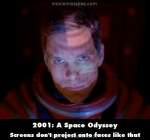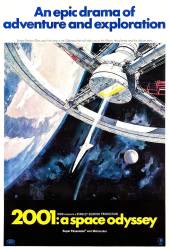Continuity mistake: The view of the front of the moon buggy shows the sunlight coming from the right side of the screen(Pilot's left shoulder) But when we see his view out the window, the sunlight casts shadows as if the sun was behind them.
Continuity mistake: Several times during Heywood's speech to the team at the moon base, his arms shift from his sides with hands in pockets to in front of him with hands on the podium.
Continuity mistake: The formation of the astronauts on the ramp to TMA-1 shifts from shot to shot.
Revealing mistake: When the astronauts are on the way to the monolith on the Moon, there are two windows seen within the interior of the small space shuttle. During their small lunch, in the left window, the horizon is seen as the surface of the Moon is flowing back against the direction of the flight. However, although sometimes this horizon fills up to half of the window, no horizon can be seen in the right window despite being located directly beside the left window. Nevertheless, the inclination of the Lunar surface should allow for it to be seen.
Continuity mistake: The Discovery's crew quarters has five beds, three for the hibernating crew, two for the Bowman and Poole. The exact beds occupied by hibernating crew changes from one scene to the next. This error is caused by Frank's last two running shots (the ones where the camera stayed just ahead or just behind him as he ran) having been accidentally reversed in editting. Frank's hair is parted on the wrong side and the sleep tube layout and the body positions within are precise mirror images of the layout seen in all prior and following shots.
Continuity mistake: When Frank receives his parents' birthday message he is relaxing on the sun-bed. As the message drags on there is some intercutting with various other views about the room. One shot happens to be of the sun-bed from an alternative angle, and Frank is nowhere to be seen. In the next shot Frank is once again lying on the bed.
Factual error: On board spaceship Discovery, the crew's living area is the spinning centrifuge, which spins about its axis to generate a gravity-like acceleration at its perimeter, the floor. When exiting the centrifuge a crewman climbs a ladder from the floor up to the hub, where there's a door leading to other parts. When Poole & Bowman climb this ladder, it's evident that they're under full body weight the whole way up. But in reality they'd get steadily lighter toward the hub. In fact, they'd be practically weightless within a few feet of it.
Continuity mistake: On board the Aries Moon Shuttle is the famous scene when the Pan Am flight attendant serves a meal to Dr. Floyd and then retrieves additional meals, enters the doorway and walks 180 degrees up the wall and over to be upside down to deliver the meals to the shuttle pilots. However, from the outside view of the spacecraft, the pilots are sitting perpendicular to where the passengers sit and she should only have walked up the wall 90 degrees.
Continuity mistake: When the astronauts are approaching the monolith on the moon, the earth is clearly seen in a gibbous phase near the horizon. In the next scene, the sun passes behind the earth, which is now in a "new" phase overhead. The earth does not change its position in the lunar sky, and certainly cannot change phase that fast.
Continuity mistake: When Dr. Heywood is talking to his daughter, her hands shift between the first full shot on the screen and the shot over Heywood's shoulder.
Continuity mistake: For most of the sequence during which the Orion space shuttle closes in to dock with Space Station One, we see the space station rotating counterclockwise, as viewed from the side the Orion is approaching. But the first two times we see the station (immediately before and immediately after the scene in which Floyd's pen floats free aboard the Orion), it is rotating clockwise. It is also apparently rotating clockwise in the shot from inside the station, looking out at the approaching Orion. The stars in this shot are turning clockwise, implying that the station is moving anti-clockwise, hence must be rotating clockwise when observed from the Orion.
Continuity mistake: When Dr. Floyd is talking to Dr. Smyslov and his colleagues, Dr. Smyslov's hair moves several times between shots.
Revealing mistake: In the sequence of the shuttle approaching the moon the pilot talks to Dr. Floyd. Floyds food-tray moves away from his knees because of the zero gravity in the shuttle. But it doesn't drift straight away, it swings like a pendulum showing that the tray is hanging on a string.
Continuity mistake: In the white hotel, the first transition shows a middle-aged Dave with graying hair. In the shot over middle-aged Dave's shoulder to show that the pod is gone, he has dark hair again.
Visible crew/equipment: During one of the scenes where an astronaut does an EVA (Extra Vehicular Activity or "Space Walk"), you see him floating slowly from the Pod shuttle towards the Discovery. This was filmed by hanging the pod on the ceiling and lowering the actor from it with a rope towards the camera that's pointing upward. If you look carefully, you can see the shadow of the rope.
Revealing mistake: When the lead ape-man is attacking and beating the rival ape-man group leader with a pig bone, the bone bends with each blow, revealing that it was made of rubber.
Revealing mistake: On the shuttle, the liquid in the drinking straw drops down instead of staying at the top in 0 g.
Revealing mistake: The classic scenes of ships in earth orbit is quite realistic, but the Earth lacks an atmosphere. Examining actual photos shows a soft glow around the edge of the earth, missing in the film.
Audio problem: On Dave's deathbed, sometimes the breathing matches his chest movements and sometimes it really doesn't.

Deliberate mistake: When Dave is in the pod arguing with Hal to let him back in, various patterns of light are projected on Dave's face presumably from the video screens that say NAV and COM and such. Light on such a screen would diffuse and not project like this. It is likely those screens had rear projection and they merely removed the screens for this effect.






Answer: This is gleaned from the Internet: The novel explains that HAL is unable to resolve a conflict between his general mission to relay information accurately and the specific orders requiring him to withhold the mission's true purpose from Bowman and Poole. HAL reasons that if the crew is dead, he would then not need to lie to them. He fabricates the failure of the AE-35 unit so that their deaths would appear accidental. In other words, HAL is asked to lie, and he doesn't take to it very well, to say the least. The conflict between his mission objectives backs him into a corner where he has to make some pretty big (and cold) leaps in logic in order to reconcile the paradox in his programmed orders.
raywest ★